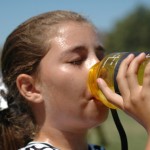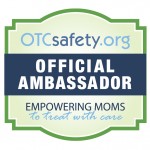As temperatures soar across the country and the humidity rises along with it, this combination can end up being dangerous and even deadly if parents and coaches aren’t up to speed on heat, hydration, and heat related illnesses in children.
I spoke with Deirdre Fitzpatrick yesterday morning about the heat and keeping our children safe. She had several great questions and I’d like to share them, along with my answers, with you.
How hot is too hot for our children to play or exercise outdoors?
- When trying to determine if your child should be exercising or training outdoors, parents and coaches should look at the heat index in their area. The heat index takes into account the outside temperature along with the relative humidity. This lets us know how hot it actually feels outside. For instance, if the outside temperature is 96 F and the relative humidity is 50%, you have a heat index of 108 F! At that level of heat and humidity, exercising and training outdoors is extremely dangerous and children should not do so. A good rule of thumb is that if the heat index in your area is 100 or more, children should not engage in vigorous activity outdoors. Practices should be rescheduled. In addition, heat indexes in the 90s are also potentially dangerous and extreme caution should be taken to ensure children are hydrated and parents and coaches are well versed in the signs and symptoms of heat exhaustion and are able to administer immediate treatment. Here is the link to the heat index chart for your reference.
What are the signs and symptoms of Heat Exhaustion?
- Heat exhaustion is the result of excessive loss of water and salt (sweat). It can have a gradual onset and manifest itself in the form of weakness, nausea, vomiting, muscle cramps (in abdomen, arms, or legs), profuse sweating, dizziness, and possibly fainting. A child’s body temperature can reach 104 F! Although the onset may be gradual, if not recognized and treated immediately, it can quickly progress to heat stroke, which is a life threatening medical emergency. Signs of heat stroke are extreme confusion, seizures, red/hot/dry skin, and a body temperature that can reach 105 F or greater! This is a medical emergency and 911 must be called.
How do you treat Heat Exhaustion?
- Have the child sit down, bring him indoors or beneath shade, and start cooling him down. Use cold washcloths, cool bath if available, and plenty of cold water to drink. If symptoms don’t start to resolve and his body temperature remains elevated, it’s wise to seek medical attention, especially since heat stroke is a major concern.
What preventative measures can be taken to lessen the chance of heat exhaustion in children?
- The number one preventative measure is for parents and coaches to be aware of the heat index in their area. If it’s 100 or higher, practices should be cancelled and rescheduled. They should aim for practice sessions in the early morning or evening if possible.
- When practices first begin, children should be allowed to acclimate to the heat by having shorter and less intense practice session in the first couple of weeks.
- Mandatory water breaks are a must. Have children drink water before, during (every 15-20 minutes), and after exercising. A child’s thirst drive is really not as strong as an adult’s, so these water breaks are imperative.
- Dress children in lightweight and light colored clothing. Skin really does need to be exposed so they can dissipate that heat in the form of sweat.
- Wear sunscreen. Sunburns interfere with the skin’s ability to sweat, so don’t skip the sunblock.
- Parents and coaches should know the signs and symptoms of heat exhaustion in order to recognize and treat it immediately. Have ice, cold packs, shade, plenty of water, and a first aid kit readily available.
What is the best way to rehydrate? Water, juice, sports drinks?
- Good old fashion water is the best by far. No juice, soda, or sports drinks. And definitely no energy drinks. Sports drinks contain excess electrolytes, sugar, and minerals that our children really don’t need unless they are engaged in prolonged and vigorous physical activity. So unless your child in training for an Olympic event, stick with the water. (Pediatrics, June 2011)
One last thought on the heat and playing outside: please go and enjoy the outdoors with your children. The benefits of outdoor play for children are numerous and children need 60 minutes of vigorous activity per day. Just remember to be cautious in times of high heat and humidity. Rehydrate your little one frequently and seek shade whenever possible.
Here’s the link to our morning Ask Dr.Mom segment on Keeping Kids Safe in the Heat.
Have you or your children ever had symptoms of heat exhaustion? What did you do and how fast did it resolve? Is your child currently practicing in the outdoors for a particular sport?










This is such great information – especially during summer camp season. My son got heat exhaustion during a baseball camp one year and after that, we have been really good at making sure he his hydrated,etc.
Thank you Paula. We definitely see a lot of this during late summer when football and soccer season begins training.
[…] exhaustion such as dizziness, fainting, nausea, vomiting, and/or an increase in body temperature. Heat related illnesses are 100% preventable and we (parents and coaches) must exercise caution and common sense before […]